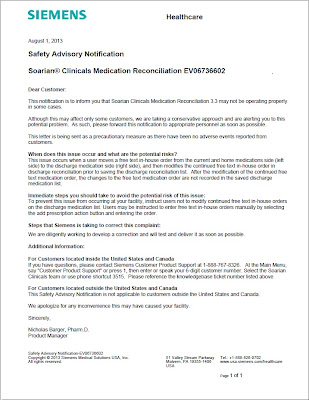There's been yet another "glitch" in the world of health IT (see http://hcrenewal.blogspot.com/search/label/glitch for more examples).
"Glitch" is a banal term used by health IT extremists (those who have abandoned a rigorous scientific approach to these medical devices as well as basic patient protections, in favor of unwarranted and inappropriate overconfidence and hyper-enthusiasm). The term is used to represent potentially injurious and lethal problems with health IT, usually related to inadequate software vetting and perhaps even "sweatshop floor in foreign country directly to production for U.S. hospital floors" development processes (this industry is entirely unregulated).
This from Siemens Healthcare:
 |
| Click to enlarge. Text below. |
Text of this "Safety Advisory Notification":
August 1, 2013
Safety Advisory Notification
Soarian® Clinicals Medication Reconciliation EV06736602
Dear Customer:
This notification is to inform you that Soarian Clinicals Medication Reconciliation 3.3 may not be operating properly in some cases.
Although this may affect only some customers, we are taking a conservative approach and are alerting you to this potential problem. As such, please forward this notification to appropriate personnel as soon as possible.
This letter is being sent as a precautionary measure as there have been no adverse events reported from customers.
They mean "no adverse events reported - yet." And if such events had been reported, Siemens would most certainly not make them public. (Why should they, when there are no regulations?)
When does this issue occur and what are the potential risks?
This issue occurs when a user moves a free text in-house order from the current and home medications side (left side) to the discharge medication side (right side), and then modifies the continued free text in-house order in discharge reconciliation prior to saving the discharge reconciliation list. After the modification of the continued free text medication order, the changes to the free text medication order are not recorded in the saved discharge medication list. [In other words, the changes to medication orders the user just typed disappear into thin air. I note that medication reconciliation failures are among the most common causes of medical error - ed.]
The health IT extremists would invoke the "Leaned Intermediary" doctrine that lays all blame for errors on the user. It seems the only way to avoid such liability would be after every "enter" or "save" action (or perhaps every keystroke?), users then verify what was saved or entered...
The "fix" to this "glitch" is not too far off from that:
Immediate steps you should take to avoid the potential risk of this issue:
To prevent this issue from occurring at your facility, instruct users not to modify continued free text in-house orders on the discharge medication list. Users may be instructed to enter free text in-house orders manually by selecting the add prescription action button and entering the order.
This is known as a "workaround." Anyone who believes this edict can and will be 100% reliably followed in often chaotic medical environments, by users from medical students to nurses to physicians, is truly cavalier.
Steps that Siemens is taking to correct this complaint:
We are diligently working to develop a correction and will test and deliver it as soon as possible.
Perhaps FDA and Joint Commission need to inquire about exactly what testing and QC was done on the current code, testing that (if actually performed) did not detect this glaring and Siemens-admitted safety-risk "glitch."
-- SS
No comments:
Post a Comment